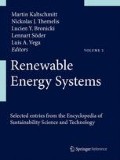Access this chapter
Tax calculation will be finalised at checkout
Purchases are for personal use only
Abbreviations
- Energy from waste (EfW):
-
Synonym of WTE used by some companies.
- Greenhouse gases (GHG):
-
Carbon dioxide, methane, and other gases contributing to the greenhouse effect.
- Integrated waste management:
-
Using a combination of all possible means of waste management so as to minimize adverse environmental impacts and optimize resource conservation.
- Waste-to-energy (WTE):
-
Recovery of the chemical energy contained in used materials by means of thermal treatment.
Bibliography
European Parliament; Council of the European Union (2008) Directive 2008/98/EC of the European Parliament and of the Council of 19 November 2008 on waste and repealing certain Directives. J Eur Union L 312/3
U.S. EPA (2009) Opportunities to reduce greenhouse gas emissions through materials and land management practices. U.S. Environmental Protection Agency, Office of Solid Waste and Emergency Response
Kaufman SM, Themelis NJ (2009) Using a direct method to characterize and measure flows of municipal solid waste in the United States. J Air Waste Manag Assoc 59:1386–1390
United Nations World Commission on Environment and Development (WCED), 1987, Our Common Future, United Nations, New York. http://www.ceres.org/about-us/our-history
European Union (EU) (2002) Decision No 1600/2002/EC of the European Parliament and of the Council of 22 July 2002 laying down the Sixth Community Environment Action Programme. Off J Eur Communities L242:1–15
Bahor B, Van Brunt M, Blue K, Stovall J (2009) Integrated waste management as a climate stabilization wedge. Waste Manag Res 27:839–849
European Union (EU) Eurostat, Municipal waste generated and treated. http://epp.eurostat.ec.europa.eu/portal/page/portal/waste/data/sectors/municipal_waste. Accessed 25 Sept 2011
USEPA (2010) Municipal solid waste in the United States: 2009 facts and figures. EPA530-R-10-012. United States Environmental Protection Agency Office of Solid Waste (5306P), Washington, DC
Arsova L, Van Haaren R, Goldstein N, Kaufman S, Themelis N (2008) 16th Nationwide Survey of MSW Management in the US: The State of Garbage in America. BioCycle
Van Haaren R, Themelis N, Goldstein N (2010) 17th Nationwide Survey of MSW Management in the US: The State of Garbage in America. BioCycle
USEPA (2011) Inventory of U.S. GHG Emissions and Sinks: 1990–2009. USEPA
Berenyi E (2009) Recycling and waste to energy: are they compatable? 2009 update
European Commission (2006) Integrated pollution prevention and control – reference document on the best available technologies for waste incineration
US EPA (US Environmental Protection Agency) (2006) Waste Reduction Model (WARM). Version 10, November 2009. http://epa.gov/climatechange/wycd/waste/calculators/downloads/WARM_v10.zip. Accessed 17 June 2011
US EPA (US Environmental Protection Agency) (2002) Fact sheet: cutting edge software to cut emissions. http://www.epa.gov/osw/nonhaz/municipal/pubs/ghg/f02024.pdf. Accessed 25 Sept 2011
US EPA (2006) Solid waste management and greenhouse gases – a lifecycle assessment of emissions and sinks, 3rd edn. U.S Environmental Protection Agency, Washington, DC
Kaufman SM, Krishman N, Themelis N (2010) A screening lifecycle metric to benchmark the sustainability of waste management systems. Environ Sci Technol 44:5949–5955
Lawrence Livermore National Laboratory (2008) U.S. Energy flowchart 2008. https://www.llnl.gov/news/newsreleases/2009/images/energy-use.pdf. Accessed 25 Sept 2011
Pacala S, Socolow R (2004) Stabilization wedges: solving the climate problem for the next 50 years with current technologies. Science 305:968–972
Shindell DT, Faluvegi G, Koch DM, Schmidt GA, Unger M, Bauer SE (2009) Improved attribution of climate forcing to emissions. Science 326:716–718
European Union (EU) (2000) Directive 2000/76/EC of the European Parliament and of the Council of 4 December 2000 on the incineration of waste. Off J Eur Communities L332:91–111
US EPA (Environmental Protection Agency) (1996) Standards of performance for Municipal Solid Waste Landfills. Fed Regist 49(61):9905–9944
Council Dircetive 1999/31/EC of 26 April 1999 on the landfill of waste. Official Journal of the European Committee, 16 Jul 1999
U.S. EPA (Environmental Protection Agency) (2008) Draft update, compilation of air pollutant emission factors, Section 2.4, Municipal Solid Waste Landfills, Oct 2008
U.S. EPA (Environmental Protection Agency) (2006) An inventory of sources and environmental releases of dioxin-like compounds in the United States for the years 1987, 1995, and 2000. National Center for Environmental Assessment, Washington, DC, EPA/600/P-03/002 F. National Technical Information Service, Springfield. http://epa.gov/ncea
FEMA (Federal Emergency Management Agency) (2002) Landfill fires: their magnitude, characteristics and mitigation. Federal Emergency Management Agency United States Fire Administration National Fire Data Center, May 2002/FA-225
US EPA (2006) An inventory of sources and environmental releases of dioxin-like compounds in the United States for the years 1987, 1995, and 2000. US EPA, Washington, DC
Author information
Authors and Affiliations
Corresponding author
Editor information
Editors and Affiliations
Rights and permissions
Copyright information
© 2013 Springer Science+Business Media New York
About this entry
Cite this entry
Bahor, B., Van Brunt, M. (2013). Waste Management for Sustainable Society. In: Kaltschmitt, M., Themelis, N.J., Bronicki, L.Y., Söder, L., Vega, L.A. (eds) Renewable Energy Systems. Springer, New York, NY. https://doi.org/10.1007/978-1-4614-5820-3_404
Download citation
DOI: https://doi.org/10.1007/978-1-4614-5820-3_404
Published:
Publisher Name: Springer, New York, NY
Print ISBN: 978-1-4614-5819-7
Online ISBN: 978-1-4614-5820-3
eBook Packages: EnergyReference Module Computer Science and Engineering

